#spop analysis
Text
i love how Adora’s second She-Ra headpiece mirrors Catra’s silhouette and that her hair retains the style she wears as Adora. it’s like now that she’s relying on her own strength to become She-Ra, her appearance reflects her authenticity and what she’s fighting for (her loved ones)
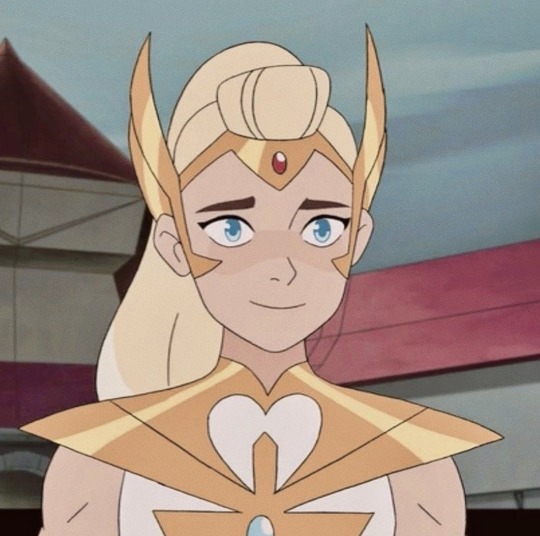
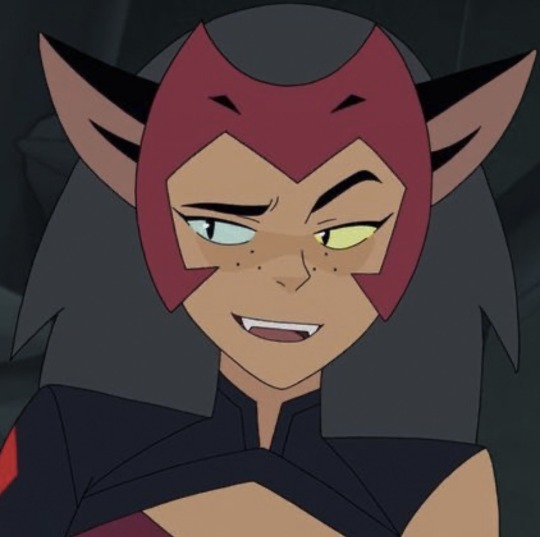
#appearance as an extension of authenticity is Very Important To Me#catradora#spop#she ra and the princesses of power#she ra#she ra adora#she ra catra#spop analysis#she ra analysis
136 notes
·
View notes
Text
SPOP And Queer Joy
Tw for transphobia, the Daily Wire, and getting kicked in the nuts
I was watching the most recent video from Some More News about a deeply stupid and bad and transphobic film from the daily wire called Ladyballers, and there was a scene they talked about where one of the main characters who was a guy that has been disguised as a woman for a couple weeks in order to win a woman's basketball tournament realizes he might actually be trans, and confesses this to the basketball coach who is his old friend and came up with the idea. The basketball coach then tells the trans character that she doesn't understand her own feelings and that the coach will help her figure it out. When she continues to insist that she's a trans woman, the coach kicks her in the nuts. And this made me realize the whole conservative mindset is based on an authority figure convincing people under them that they don't understand their own feelings and they don't know who they are, but the authority figure does. And the point of it all is to make someone never trust themselves or their own feelings ever.
And then I thought of the ending of She-Ra.
And I finally get why it felt so right and so triumphant and so different. Catra and Adora have been living with Shadow Weaver their whole lives, and Shadow Weaver has constantly been telling them who they're supposed to be, and it hurts both of them so much over the course of the series because Adora keeps trying to fit herself into that mold better (is helped in this endeavor by light hope) while catra is trying to break out of her mold to put herself in Adora's as the golden child
And then hoard Prime shows up as the ultimate example of an authority figure insisting that you don't understand yourself with the chips, which are literally a direct physical implementation of that idea!
And in what both of them think are their final moments alive, they kill the shadow Weaver in their heads, trust themselves to know who they are, and do what they've wanted to do the whole time. Catra stops trying to prove herself and admits that she cares and wants to just be enough without having to try. She stops caring about whether she's weak and says she loves someone. Adora stops trying to be the self-sacrificing hero and acknowledges that she can care about other people differently than just having to save them and she finally takes something she wants without worrying about the consequences.
They both say "screw authority, I know who I am and I'm going to let that out" because they both think they're about to die. And that one tiny moment of rebellion and understanding saves the entire goddamn universe. It terrifies Prime to the point that he can't even comprehend what's happened, and then it obliterates him and frees everyone he's ever hurt. It fixes everything
That one moment of queer Joy, even at the very end of the world, is all that it took.
76 notes
·
View notes
Text
How She-Ra and the Princesses of Power Uses Traditional Fairy Tale Archetypes and Motifs to Reinvent the Love Story
(This is based on a 15-page final paper I wrote for my Queer Theory class last semester. Link to that if you want to read it or see the format is at the end.)

The SPOP finale is one that consistently has me SOBBING. Not only because it’s such a beautiful portrayal of a kiss shared between two female leads portrayed on a kid’s show, but because the kiss itself is so utterly significant to the story that I cannot see a more perfect ending for the climax overall.
What really struck me thinking about it later on was the fact that traditional fairy tales have always made me hate the “true love’s kiss saves the world” trope because it has always felt so ingenuine, and yet for the SPOP finale, it could not feel more genuine and real (and it wasn’t just because I loved seeing a queer kiss because prior to this I’ve had many straight ships I’ve enjoyed). The deeper I fell into investigating the structure of SPOP and the motifs it uses (She-Ra as a savior, Catra as a villain, princess tropes, etc), the more I understood that this show isn’t just revolutionary to queer animation, it’s revolutionary toward the fairy tale love story as a whole, and I’m going to explain why.
The world of Etheria is one that exists without a dominant sexuality or gender. It’s something I’ve began to notice more in my favorite shows (the two that I can think of off the top of my head is SPOP and The Owl House). These fantasy worlds portray sexuality without putting so much significance to it--Bow and Willow have two dads and nobody bats an eye, they/them pronouns are used so casually you’d think it’d be the norm in the real life, Amity’s mom doesn’t approve of Luz not because they’re both girls but because she’s considered a criminal and she wants to get her a different girlfriend--notice how queerness is something that just exists, there’s no "coming out” or no queerphobia because it just doesn’t exist. People just are who they are and love who they want to love. It’s as if every sexuality and gender is treated with normalcy.
The best example in SPOP is the whole episode involving Bow coming out as a rebel to his gay parents. The whole irony of the situation just establishes that queerness is not considered out of the norm in Etheria. If it did, you’d see some sort of reference to the way his dads had to come out to their family or their community in some way, but you don’t because they didn’t have to come out. There is no closet when it comes to gender and sexuality in Etheria--you just are who you are.

There’s this very interesting concept called the “heterosexual imaginary” that basically states how straightness is basically invisible in our world because it’s considered the norm (the essay Sex In Public by Berlant and Warner describes it as “the givenness of male-female sexual relations [that] is part of the ordinary rightness of [our] world”). This imaginary or “givenness” does not exist in the universes of SPOP and TOH, and it is why these stories can pull off queer relationships and characters without needing the stereotypical coming out episode or homophobia episode a show based in our world would generally have. You’d think it’d be a norm in every fantasy world to have this seeing as it’s a fantasy world and it’s weird that one would function with our set of norms but anyway.
This directly ties to a quote that Stevenson made that I just love:
The show’s not a romance show. It is about a lot of things. It’s about choice, destiny, fighting, tyrants, you know, all of these other things. I grew up with so many stories—like sci-fi and fantasy—that I was so passionate about. And it would be considered no big deal to have the hero get the girl and to have a kiss at the end, without it suddenly becoming a romance or ‘Oh, the shippers got what they wanted.’ It was just a part of the story.
We see this in sooooo many fantasy stories! If it was any other sexuality, you’d see these kinds of arguments all the times--”shoved in your throat,” “inappropriate,” “not for kids”--we see these arguments all the time when it comes to queer relationships but nobody bats an eye when a guy gets the girl at the end of a coming of age journey, do they? It doesn’t suddenly turn the whole story into a straight romance, it’s just a part of the story. That’s the heterosexual imaginary in action!
Now, when it comes to traditional Disney fairy tales, oh boy do we get compulsory heterosexuality everywhere. These stories already have a reputation for building a pretty unhealthy view of romantic love (or assuming that all love is romantic in the first place), though they have been getting much better at it (and by better I mean Pixar... it’s literally Pixar holding their weight).
Especially when it comes to princess stories, “a heterosexual romance is inevitable and often a central conclusion” (England, Descartes, & Collier-Meek 565).

Let me make it clear: SPOP is not a romance. It is a love story, but it is not the romance, and here’s the difference.
A love story uses a romantic relationship (or another type of relationship between two people who love each other) as an impediment or a facilitator to focus on a message outside of romantic love. A romance focuses on the actual romantic relationship itself.
These terms are often confused because the “traditional Disney definition of true love” (Rojas 13) shapes our expectations of a love story. In framing this heterosexual love as the primary purpose of female leads, these stories “help to reinforce the desirability of traditional gender conformity” (England, Descartes, & Collier-Meek 565). They build narratives that revolve around a princess (who upholds feminine ideals) finding her prince (who upholds masculine ideals) and depict their love as relying on their “fated” bond that “cements over the course of… one meeting” and that “endures a test where the man overcomes hardships and succeeds in rescuing the woman from evil” (Rojas 13). This love story ends with a kiss, a marriage, and a happily ever that upholds the social order.

Since these love stories shape our perception of love as children, as adults, we interpret ‘true love’ as a frivolous concept that only exists in fairy tales; as such, it is common to discredit the romance genre for its superficiality and degrade the message of any love story to this expectation of superficial love. Consequently, because “the givenness of male-female sexual relations” (Berlant & Warner 168) allows heterosexuality to function in a state of invisibility, heterosexual love stories can end with a romantic union without it demeaning the story whereas queer love is degraded to ‘just another dumb love story’ instead of “a part of the story” (Stevenson).
But Catradora isn’t just another dumb love story. It is the foundation of SPOP as a whole because it’s what drives the story. The most interesting part is that SPOP uses so many traditional motifs that you’d think would only serve toward maintaining patriarchal norms and it uses them in such a meaningful way that transforms them into so much more!
Let’s start with the character motifs--the savior, the princess, the villain, and the damsel (and there’s a reason why I am separating the princess and the damsel). Adora functions as a savior and a princess while Catra functions as a villain and a damsel, and I know it sounds ridiculous right now but hear me out. The gender messaging inherently attached to these archetypes are a part of the narratives that Shadow Weaver builds to manipulate them so she can have control over them.
Let’s start with the savior, aka the knight in shining armor. This one’s pretty easy to tie to Adora because her savior complex is what drives her whole arc. But I’m taking it further to explain how it ties to the messaging behind the archetypical savior. The knight in shining armor archetype is build upon the foundation that a woman is a man’s responsibility--it is clear the man is generally the one portrayed as independent and the woman he must save is the dependent. The woman needs the man to live. We see this archetype in sooo many princess stories (Rapunzel, Snow White, Cinderella, etc.) Now think about the way Shadow Weaver manipulates Adora to adopt this mindset.

Shadow Weaver expects Adora to “[keep Catra] under control” (”Promise” 16:48), that what Catra does is her responsibility as if Catra isn’t her own person outside of Adora. This is what builds Adora’s “caretaker” role in their codependent relationship at the beginning of the series--this is what causes her to adopt her savior complex.
Similarly, as a scapegoat, Catra was conditioned to be Adora’s ‘taker,’ and Shadow Weaver viewed her as a “nuisance… [only kept around] because Adora was fond of [her]” (16:20). This narrative results in Catra’s Cinderella Complex, the “repressed attitudes” that lead women to believe “they are simply damsels in distress and will remain so until the rescue of their male suitors” (Saha & Safri qtd. in Ding 23), at the beginning of the story, for as the damsel archetype upholds, a woman is worth nothing past being an extension of the man that owns her. In this sense, Shadow Weaver describes Catra as an extension of Adora—everything she does is tied back to Adora, for she does not have an identity outside of her. Catra needs Adora to survive--both emotionally and literally because who knows what Shadow Weaver would’ve done with her had Adora not been “fond of her.”
When Adora defects, their codependent roles collapse, and following her ‘caretaker’ role, she seeks to be the savior as She-Ra whereas Catra entirely loses the person she relies on for her sense of self. Seeking her worth elsewhere, Catra pursues their original goal to move up the ranks of the horde alone, and deep into her resentment for being abandoned by her ‘caretaker’ and the only person she loves, she turns to villainy and seeks to defeat Adora.
The scene that most clearly portrays this savior-damsel dynamic between Adora and Catra at the beginning of the story is “Promise.”
“Promise” highlights her rejection of her damsel narrative when Adora fails to save Catra from being dragged away by the spider. We see her default into helplessly calling for Adora with tears in her eyes even though we know she’s capable of taking out that spider herself, she still instinctively fills her damsel role and calls out for Adora to save her. Then we see her look into an empty hallway, and it’s almost as if this is what goes through her mind: Adora abandoned me, therefore Adora is not coming to save me, but I don’t need Adora to save me, I can save myself.
Consumed by her resentment over Adora breaking her narrative and being confined within her own, she proves Shadow Weaver wrong by resolutely fighting back—a capability she always possessed but that her dependency on Adora and Shadow Weaver’s manipulation prevented her from acting upon.
Alongside that, Adora’s ‘heroic’ save just before Catra finishes off the spider and her condescending chuckle and “sure you did” after Catra argues that she “had it” (13:47) emphasize how ingrained these detrimental narratives are within their perceptions, for the mere idea of Catra not needing her is a joke to Adora. The purpose of “Promise” is to divorce Catra from her Cinderella Complex, but in spite of abandoning this narrative, she falls into another by misconstruing Adora’s heroism as a manipulative tactic to hold her back (20:07), and it drives her into her obsession to make Adora fail to prove herself that she can be above.

Yet Adora’s Savior Complex was also a result of Shadow Weaver’s manipulation because, apart from enabling Adora’s belief that she was responsible for Catra, she believed her worth relied on her success as her prodigy. As Kyle the Scott explains in his video essay about the hero mindset, SPOP “does not present the argument that heroism is bad” but it “[questions] how healthy the hero mindset really is… [and] what kind of effect thinking of yourself and others in this way have on a person” (Scott, 7:58).
Throughout the series, it is made clear that Adora’s Savior Complex not only drives her to believe she is worth nothing past her destiny to save Etheria but that she is the only one capable. This belief relates to Adora’s state as a princess, for in the way a passive princess must give everything of herself to serve her man and her society, Adora had to give everything to earn Shadow Weaver’s motherly love, and, later on, she had to give everything to become the hero of Etheria. As such, Adora is not passive in that she is powerless, she is passive in her state as a chosen one lacking agency over her destiny and her belief that her worth relies on what she can offer others.
This extreme selflessness or “ability to show love” (Davis 125) contrasts Catra’s state as a villain, otherwise characterized by her predisposition toward hatred or her “[inability] to demonstrate love” (Ding 15). The archetype of a villainess sends the message that it is “wrong and deceitful for women to be independent and powerful… [and pushes] them to adopt more submissive roles and behaviors” (Ding 16). While Catra describes Adora as a “people-pleaser” (which confines her within her princess archetype), Catra has always steered toward rebellion because Shadow Weaver put her down no matter what she did right, and her rebellion (or “disrespect” as Adora calls it) is deemed a negative because it gives Shadow Weaver less control over her in the same way the archetypal villainess is demonized for defying gender roles.
However, Catra’s descent into villainy was another narrative she confined herself to because she sought power to prove her strength to Shadow Weaver and everyone who put her down, but internally, it was a method of self-preservation since she no longer had her ‘caretaker’ to protect her. As Catra gains power and attempts to convince herself she hates Adora, it becomes evident that her motive was never “ruling Etheria,” it was always about the two of them staying together. Hence, Catra is not a villain because she is heartless or because she craves power; it is due to her use of lashing out as a method of self-preservation and her inability to express her emotions that she falls into the cycle of self-destruction that makes her one. As such, Adora and Catra’s detrimental actions and beliefs about themselves are driven by these confining narratives Shadow Weaver imposed on them which mirror the gendered messages behind these archetypes, and it is these narratives that they transcend at the climax of their love story.
Now let’s fast forward to the Season 5 during the episodes they spend outside of Etheria, specifically I’ll focus on “Corridors,” “Save the Cat,” and “Taking Control” because these are the key for the foundation of Catra’s redemption, Adora’s growth, and the reconciliation of their relationship. This will help prove the power of their love is what helps them break away from their narratives (and it sounds so cheesy but it’s executed so well you barely notice).
I’m going to quote a lot of Five by Five Takes on Youtube because she has some AMAZING takes of this show. Catra’s reflection in “Corridors” reveals that her fear of abandonment ranged back to their childhood, for when Adora made friends with others, Catra perceived it as an attempt to replace her—that if “she wasn’t Adora’s priority… she didn’t matter at all” (“She Ra's Corridors Isn't What You Think” 1:43).
Now, having pushed everyone away for her power trip, at the last step of her journey to the top, when she reflects upon Adora’s words as a child, she recognizes this “safety, friendship, love she turned away from because she didn’t believe it could be real” ( “She Ra's Corridors Isn't What You Think” 1:46) and realizes that resigning herself to villainy is not her only path, for “it’s only too late when you’ve resigned yourself to that” ( “She Ra's Corridors Isn't What You Think” 4:47).

In her choice to save Glimmer, she breaks her cycle of self-destruction and “reclaims her identity… her narrative, to be about her [and] not about someone else” (“She Ra's Corridors Isn't What You Think” 3:08). It is the memory of her love for Adora—the love she rejected because she confined herself to her villain narrative to keep herself safe and to prove she could form an identity outside of Adora—that sets her on her path to redemption. So in this way, their love impedes and facilitates Catra’s coming-of-age journey because it was her attempt to reject this love that drove her into villainy and her acceptance of it that gets her out.
“Save the Cat” is a turning point in Adora’s journey because, in breaking out of her savior and princess narratives, she discovers that She-Ra is driven by her most authentic self. By choosing to rescue Catra, Adora puts her responsibility as a hero aside and acts for herself. For once, her decision is not selfless because she’s endangering her team and Etheria by going to save someone who has been the villain for so long.
She also does not make this decision because she feels responsible for Catra, for we see her abandon this feeling in the episode “The Portal” when she stops attempting to pull Catra into the good side and stops holding back during their confrontations now that she understands Catra is her own person and that she is not responsible for her bad decisions.

Thus, in saving Catra because she has hope for her and not because she ‘needs’ to, Adora rejects her savior and princess narratives. Furthermore, it is the “need to protect” the person she loves and her “purity of emotion” that allows her to channel her most powerful and authentic self (Stevenson), so while Prime embodies lack of identity and agency, Adora embodies embracing love and authenticity. Along the same lines as Catra, Adora confined herself within her narratives by putting her obligations above her feelings for Catra, and she freed herself from them by putting the person she loves above the world.

“Taking Control” marks another turning point in their relationship because we see them communicating and actively reconciling their relationship. By putting herself in a vulnerable position and telling Adora that “[she wants] to go home” (16:56) despite having told Glimmer “there is nothing left for [her there] (“Corridors” 6:20), Catra implies that Adora is her home, and, in making an active effort toward fixing her anger issues and getting to know Adora’s friends, she shows she wants Adora to be part of her life again. Furthermore, the way she lets Adora help and comfort her shows she no longer links vulnerability to being submissive, and she puts aside her fear of falling back into her damsel narrative now that their separation has given her time to find an identity outside of Adora.
So these three episodes mark a turning point for their relationship—one that is no longer based on dependency but on supporting each other’s growth, being honest about their mistakes, and letting themselves be vulnerable.
And then... “Failsafe” happens.
Their return to Etheria is also their reunion with Shadow Weaver, and their regression into her narratives impede them from admitting their feelings for each other and being authentic to themselves. Once more, they get stuck in these narratives Shadow Weaver has weaved into their core.
The good news is their growth and the progress they have accomplished in mending their relationship reflects in the way they reject Shadow Weaver’s influence and defend each other. Furthermore, the improvement of their communication reflects in the way Catra voices why she is upset and Adora expresses she needs Catra by asking for her support. So their rejection of Shadow Weaver’s narratives allows them both to support and be supportive, and their relationship is no longer codependent because they exist on equal grounds now.
Unfortunately, Shadow Weaver’s presence still triggers Catra’s insecurities about feeling wanted and Adora’s fear of failure.
Shadow Weaver uses their reconciliation to her advantage in the way she weaponizes Adora’s feelings for Catra by convincing her she must focus on “protecting [Catra]” instead of letting her distract her. She also breaks Adora’s identity apart by describing She-Ra as an entity outside of her, even though She-Ra is Adora at her purest ( “the world needs you as She-Ra… not Adora” (”Failsafe” 12:12).
Thus, Adora’s regression into her savior complex turns her into a martyr, for what she wants for herself does not matter because she must protect the world and her friends. In telling Catra that “even if [Shadow Weaver] is [sacrificing her]… [it] is the only way” (16:29), Adora conveys that she is, yet again, willing to abandon Catra and sacrifice her own life for the rest of the world even though, as Catra tries to convince her, “it doesn’t always have to be [her]” (17:54).

Here, Adora regresses so deep into her narratives for fear of losing those she loves that she believes she is acting of her own volition and not Shadow Weaver’s influence. Yet Adora does not have to be the one to make a sacrifice; as Catra points out, Shadow Weaver is capable of taking the heart herself, but she does not because she knows Adora’s savior complex will drive her to believe it has to be her.
In asking her what she wants, Catra is really asking Adora to choose between their relationship and her heroism, and when Adora responds that “[she has] to do this” (21:25), Catra perceives it as Adora willingly resigning to Shadow Weaver’s narrative by “[choosing] Shadow Weaver and not [her]” (“The Heart (Part 1)” 4:56) and not loving her enough to stay because she has never needed Catra (21:40), so she leaves. In the same way Adora acknowledged Catra was her own person who made her own choices in the episode “The Portal,” Catra acknowledges here that she cannot change Adora’s choice no matter how self-destructive it might be. Hence, it is their failure to accept their true feelings that hold them back from being authentic to themselves, for Adora does not allow herself to want and Catra does not want to confess because she believes “Adora doesn’t want [her]... like [she wants] her” (“The Heart (Part 1)” 5:00).
And now, finally, let’s talk about true love’s kiss--one of the oldest fairy tale tropes in the book.
True love’s kiss is the deus ex machina of countless fairy tales, but although true love’s kiss does save the day in SPOP, its significance relies on Adora and Catra transcending the narratives Shadow Weaver imposed upon them and embracing their love and their authentic selves. It is not merely a magically ending--it is them admitting what they’ve been holding out on for FIVE SEASONS that allows She-Ra to transform. That is how they save the world. Stevenson says it himself:
This moment of confession is the climax of the show. It is everything [they have] been building up to.”
Even though it is its magic that saves the day, true love’s kiss feels authentic here because of what the magic represents. In SPOP, magic stands for authenticity, connection, and love—all of which express humanity.
At the climax of their story, having lost her ability to transform, Adora begs Catra to leave so she can do the next part on her own—primarily, Adora knows how much she has hurt Catra, so she does not want her to witness her sacrifice. Catra’s choice to stay is a selfless act because she willingly puts herself in a vulnerable position by risking being hurt in the worst way possible. Meanwhile, Adora’s “beautiful wish,” as Prime calls it, externalizes what she wants and is not letting herself have because “[she is] She-Ra” and sacrificing herself “is what [she is] supposed to do.” However, in expressing that “[she deserves] love too” (“The Heart (Part 1)” 17:32), Mara tells Adora that she is allowed to be selfish—she is allowed to want and to receive love. She is “worth more than what [she] can give to other people” (17:30). So in confessing her love, Catra externalizes Mara’s words to Adora.

Despite her best friends claiming to love her for her and not She-Ra, Adora cannot be certain of this because they only became friends after she found the sword. So when the person she cares for the most and who she has also unintentionally hurt the most reveals that she not only loves her but that she has always loved her, it disproves her damaging perception of her worth. It allows Adora to unchain herself from the narratives that have been holding her back from expressing her wants and her feelings. When Adora confesses her love, she chooses Catra for the first time, and she disproves Catra’s belief that Adora does not want her.
The magic behind their true love’s kiss does not rely on superficial rules about love that paint it as a fantasy. On the contrary, it is the humanity behind it—Adora’s acceptance that she deserves love and a future for herself, her rejection of the expectations the world has reduced her to, and their mutual love—that gives Adora the power to transform and save Etheria. In opening their hearts, the magic at the heart is released and it revitalizes the planet, reverting it to its authentic state in the same way it does for them. As Five by Five Takes points out, we even see this in the amount of ‘I love you’s’ exchanged between all the characters—between lovers, friends, and family. The climax also contrasts their narratives, for as opposed to saving Catra, Adora is saved by Catra, and Catra’s “inability to show love” as a villain opposes the way her showing her love saves the world.
As Five by Five Takes explains in her video How She Ra Gives Us Hope, “the conflict [of SPOP] was never love or power, it was authentic connection versus outside manipulation: our genuine selves against the constructs imposed on us” (10:13). Having been divided and at odds for five seasons, having been abused and forced into narratives that stripped them of their identity and agency, and having grown and experienced hardships together and apart, concluding the story on a mutual confession and a true love’s kiss between Adora and Catra establishes their feelings, their wants, and their love are connected to the core of their identities and their coming-of-age journeys as they exist with and outside of each other.
“With Disney specifically, their conceptualization of romantic love is one that follows along with a set of ideals that define perfect love” (Bell, 1975; Sprecher & Metts, 1989 qtd in Ding, 2021), and it is these limitations that paint love as an unachievable fantasy that make these love stories superficial. These stories depict idealized models of men and women that are nothing more than hollow shells written into narratives confined by heteronormativity and gender norms. Such as the ones Shadow Weaver imposes upon Adora and Catra, “whatever you call them—narratives, expectations—these things that tell us who we are, really, are just about control” (“How She-Ra Gives Us Hope” 16:11).
SPOP illustrates a beautiful love story that can serve as a metaphor for the way queer love can rise above the narratives heteronormativity confines it within while reinventing the same archetypes and motifs traditionally catered to reinforcing this heteronormativity and without resolving to topics like homophobia or discovering sexuality, for, in Etheria, love is humanity and love is love. Whereas the resolution of Disney love stories relies on princesses giving up their agency to pursue their role as a wife and a woman in a patriarchal society, SPOP has both its female leads rejecting narratives that allow them to reclaim their agency, their identity, their lives, and their love, not only in their universe but also in ours.
Then there’s the “happily ever after” motif. In Disney fairy tales, happily ever after’s capture beautiful images with “little details” like “fireflies, butterflies, sunsets, wind, and the beauty and power of nature… a link to the naturalness of hetero-romantic love… [that depict] these loving scenes of heterosexual love as the most natural and magical form of love” (Ding 34). In this way, it teaches children “a distorted concept of romantic love at… a young age” that “poses an issue for the harsh reality that love and relationships actually exist as” (Ding 49).
The ending of SPOP captures a magical scene similar to the one described above where Adora and Catra stand upon a hill with their foreheads against each other before a rising light in a new and healing Etheria. Ironically, this beautiful image is not heartwarming because it glorifies their relationship. Their love story was never perfect—there was hardship, tragedy, mistakes, and heartbreak. Instead, the warmth in this image comes from the characters’ perseverance, acceptance, growth, and hope. It comes from having witnessed the coming-of-age stories of two abused best friends who have finally reunited and confessed their love.

Even though SPOP is a fantasy, in Etheria, true love is authentic—it is not a fairy tale concept. Its magic is intrinsically tied to the human truths expressed through its characters and their stories. SPOP redefines a love story by giving these traditional fairy tale motifs a purpose past enforcing gender norms and a glorified image of heterosexual love. Thus, it proves it is possible to redefine the fairy tale love story outside of these heteronormative narratives for “to be against heteronormativity is not to be against norms” (Berlant & Warner 170) nor is it to condemn these motifs or eliminate them from love stories altogether. Instead, we must infuse them with a new meaning—one that focuses on the truths and the complexity behind our humanity—that conveys the message that love is real and that love is love without losing its magic.
If you got this far, thanks for reading :)
(Original essay linked in the notes)
Works Cited
Berlant, Lauren, and Michael Warner. “Sex in Public.” The Routledge Queer Studies Reader, 2013, pp. 165–179.
Brown, Tracy. “In Netflix's 'She-Ra,' Even Villains Respect Nonbinary Pronouns.” Los Angeles Times, Los Angeles Times, 6 Nov. 2019.
Davis, Amy. Good Girls and Wicked Witches: Women in Disney's Feature Animation. John Libbey Publishing. 2007.
Ding, Shay. Overexposure to Disney Princess Animated Films: Disfigured Perception of Gender and Love In Adolescents. 2021.
England, D.E., Descartes, L. & Collier-Meek, M.A. “Gender Role Portrayal and the Disney Princesses.” Sex Roles 64, 555–567, 10 February 2011.
“Failsafe” She-Ra and the Princesses of Power, created by Noelle Stevenson, season 5, episode 11, Netflix, 2018.
“How She Ra Gives Us Hope.” YouTube, uploaded by Five by Five Takes, 29 July 2020.
“Promise” She-Ra and the Princesses of Power, created by Noelle Stevenson, season 1, episode 11, Netflix, 2018.
“Reunion” She-Ra and the Princesses of Power, created by Noelle Stevenson, season 2, episode 7, Netflix, 2018.
Rojas, Camila. Confronting Traditional Love: The Evolution of the Representation of ‘True Love’ in Disney’s Princess Movies (1990s to the Present). 2015. Universitat Autònoma de Barcelona, dissertation.
Scott, Kyle. “She-Ra and the Hero Mindset: Video Essay.” YouTube, uploaded by Kyle the Scott, 24 March 2021.
“She Ra's Corridors Isn't What You Think.” Youtube, uploaded by Five by Five Takes, 8 August 2020.
Stevenson, Noelle. “She-Ra’s Noelle Stevenson Tells Us How Difficult It Was To Bring Adora And Catra Home.” Interview by Beth Elderkin. Gizmodo, 13 July 2019.
Stevenson, Noelle. “She-Ra showrunner, stars break down Adora's new look with exclusive clip.” Interview by Christian Holub. Entertainment Weekly, 16 May 2020.
“System Failure” She-Ra and the Princesses of Power, created by Noelle Stevenson, season 1, episode 6, Netflix, 2018.
“The Heart (Part 1)” She-Ra and the Princesses of Power, created by Noelle Stevenson, season 5, episode 12, Netflix, 2018.
“The Heart (Part 2)” She-Ra and the Princesses of Power, created by Noelle Stevenson, season 5, episode 13, Netflix, 2018.
#spop#she ra and the princesses of power#catradora#adora#catra#spop analysis#spop spoilers#sapphic#queer love
584 notes
·
View notes
Text
Vi : you re hot cupcake. So what will it be, men or women?
Catra: she stole my food and asked me to spy on people with her; is this what love feels like?
They killed Heteronormativity
#arcane league of legends#arcane vi#arcane#league of legends#vi arcane#violet arcane#heteronormativity#shera catra#spop fandom#spop catra#she ra spop#spop analysis#spop#she ra princess of power#shera analysis#shera#catra shera#wlw#wlw post#wlw love#wlw lesbian#sapphic
63 notes
·
View notes
Text
SPOP and “Choice”
Spop has a secret theme, something that connects all the characters, and that theme is “Choice” and every important character embodies it. I mean, look at the best friend squad, each of their stories explores a different facet of choice.
Adora- Adora has never had choice. Everyone, from the Horde to Light Hope to Shadow Weaver to the Rebellion all deny her choice. In season three, she called out Catra’s choices, figuring out what is and isn’t her fault. In season four she rejected her destiny and made a choice to save the world by smashing the sword. In season five she finally makes a choice that benefits herself (the choice to go back for Catra near the heart, and then the choice to stay alive and kiss Catra at the heart). Obviously there’s more to say about Adora and choice, because she’s the main character and so the theme is most obvious with her.
Catra- Catra’s story, like Adora’s, is about embracing choice and rejecting destiny. Her destiny just isn’t as obviously stated as Adora’s as it comes from trauma and is most enforced by Catra herself rather than an external force like light Hope. Her “destiny” is to be trapped in the cycle of pain and abuse forever, and although it seems like she’s making choices, she’s just reacting out of fear and anger for most of the show. However, when she chooses to live and try to be better, she is finally making choices and not letting her life be defined by those who hurt her.
Bow- Bow is a fairly static character, but his arc with his dads is about him making a choice to go against the plan others had for him. (Because unlike sexuality, being a fighter is actually a choice)
Glimmer- Sparkles is the odd one out. She has already rejected authority (Angella) and is making choices all the time. Her arc is about learning that her choices have consequences when she becomes queen. She learns that she has the power of choice (and she maintains this power on horde primes ship no matter how much he tries to take her choice away) and that she has to do the right thing with it.
Also Horde Prime is literally the embodiment of an absence of choice. I don’t feel like I have to explain that one it’s pretty obvious.
Also light hope and shadow weaver both manipulate people into thinking they don’t have choice. I could go on forever.
Please please rb with your thoughts I know there are so many smart ppl in this fandom I want to hear what y’all think.
#she ra and the princesses of power#she ra#spop#spop catra#shera#catra#spop adora#adora#spop glimmer#spop bow#spop analysis#spop meta
209 notes
·
View notes
Text
honestly fascinating how I didn't perceive Catra as an angry character until she pointed out that she was working on it in s5
I think that at the time I watched the show (high school 2018-2020), I related to her so hard and was so entrenched in her perspective, that most of her angry responses felt righteous and perfectly reasonable. And to be fair, Catra's angry reactions do make perfect sense given the environment she's in. They track perfectly because she's well-written. I was just like "huh, I guess that is a thing she could work on"
#cl thoughts#catra#ngl it pissed 2020 me off bc it felt like the show was downplaying the context surrounding her anger#and like Catra tried to repress it for such a long time to spare others (Adora then Scorpia) before releasing it in Promise & again in s3#but in retrospect girly needed to take a chill pill at times lol#catra analysis#spop#spop analysis#catradora#bro she was such a cathartic character for me#i love her sm#jlmfr
16 notes
·
View notes
Text
Hey, Joye poked out of her Death Note corner to talk about She-Ra again! Please remember that if you click on this post you are responsible for being a nice and sane human being. Violations of this rule will result in a block. :)
In other shows, such as ATLA, Hunter x Hunter, Death Note (2015), and even with She-Ra itself in regards to Adora, the “person gets possessed by an evil something and has to fight someone they love” trope is my J A M. It’s one of my favorite things ever and I love it. But I realized a key difference in these shows compared with Save the Cat that I really think needs to be pointed out.
Catra is NOT a good example of that trope.
What do I mean? Simply put, Catra’s words and actions when she’s chipped are just…entirely the same as they are when she’s not. She still berated, physically hurt, and gaslit Adora without Prime’s help. Not a whole lot changed aside from her autonomy (which is not insignificant but also not the point of my post), but what narrative change does loss of autonomy accomplish when Catra was exactly like that not an episode before?
And before y’all point out Shigaraki, it’s different because Shigaraki was groomed into believing he DID have a choice his entire life. His whole arc up to the PLW arc was coming into his own at All For One’s encouragement. It’s entirely different because All For One snatched that away from him completely after dangling it in front of his face for 15 years.
Shigaraki’s loss of autonomy is sad because his whole life is about the illusion of choice - unlike Catra, whose whole life was an inferiority complex. (This also makes Shigaraki more similar to Hordak than Catra, but I digress.) The backdrops of their arcs are entirely separate from one another despite seeming similar on the surface. And it’s also worth pointing out that Shigaraki as of the MVA arc had a goal - to destroy the status quo and live as he and his band of rejects wanted to. Unlike Catra, who only wanted to destroy everything and one-up Adora, Shigaraki was not an abuser who kept abusing after he lost autonomy, but a young man with a sympathetic dream who lost it to an ACTUAL child groomer and abuser.
TL;DR: Catra’s autonomy loss in S5 is not sympathetic and not a good example of that trope, especially compared to characters like Shigaraki.
#spop#she ra#anti catra#analysis#media analysis#spop analysis#mha#bnha#shigaraki tomura#tomura shigaraki#shigaraki
27 notes
·
View notes
Text
My Inane SPOP Musings #329:

So... how are murder mysteries (like Mer-Mysteries) a thing, on a planet that has access to truth spells? E.g.:
Lord Diddlesworth: I was nowhere near Marlenna's bedroom at the time of the murder!
Sorcerer: Zappity-Zap
Lord Diddlesworth: Oh fuck it, I killed her.
#it's a conundrum#yes this is what goes through my head#24/7#spop#spop analysis#she ra#she-ra#shera#mermista#mer-mysteries#mermysteries#glimmer#truth spell#magic#spop shitpost
23 notes
·
View notes
Text
My mum and I just had a huge argument over Catradora. I know it sounds stupid, but bear with me. She's extremely homophobic, but we had a deal that she would watch She-ra with me, and she would tell me what she thinks after seeing good, healthy lesbian representation.
She loved the show - she said it made her think about a lot of things. One thing she didn't like, though, was Catradora. I thought I'd break down a few of her arguments for y'all.
They were better as friends, and sexualising their intense friendship trivializes it. - What does this even mean? First of all, no one is "sexualising" their friendship. They kissed. The end. It's a kid's show. Presumably she means making it into a romantic relationship. My argument here is that the relationship was clearly built up from the beginning to be romantic - so why shouldn't they kiss? Next, the word "trivializes" really doesn't sit right with me. I think what she means is "Catra and Adora being in love doesn't sit right with me because the show would be a lot deeper if they were best friends, rather than being motivated by romantic intentions". So what you mean to say is, Catra wouldn't have saved Adora's life if she didn't feel a need to get into Adora's pants? Between you and me, I think someone is trivializing the relationship here. And I don't think it's the show creators.
I didn't see it coming. - Dude, you're a homophobic woman. When two women look at each romantically, of course your brain is going to jump through hoops trying to justify it until your brain reaches some platonic conclusion. In all seriousness, though - you would've seen it coming if it was about a man and a woman. That was the way the show designed, specifically a romance between two women.
Glimmer and Bow's relationship was the natural progression. Catra and Adora's wasn't. - Again, you only saw it coming because it is a romantic relationship between a man and a woman. Catra and Adora's relationship was more heavily hinted that Glimbow. That's you being oblivious, and not the fault of the show creators.
There isn't enough representation of non-sexual female friendships like that in media. Sexualising it ruined it. - I think this one speaks for itself. There is clearly not enough lesbian media, but my mum just doesn't want to see it. Also, it is much more important as a love story between two women than it is as a story about friendship. Because as stupid as it sounds, representation is really important! Some kid is going to see Catra and Adora kissing on screen and think: "they're just like me. I'm not alone." - and that is so important.
Again with the trivializing argument - nothing is getting trivualized just because they are choosing to enter a romantic relationship. And why shouldn't they? It's the natural progression, because, surprise surprise, they are in love. But nothing has changed. Whether they stayed as best friends or kissed, their dynamic is still the same, and it is an incredibly touching one at that - and it is not the dynamic itself that my mum has a problem with. It is the fact that they chose to enter a romantic relationship. More specifically, the fact that two women freely chose to enter a relationship.
To conclude, I think these arguments mostly boil down to a severe case of homophobia, though she won't admit that. As I said earlier, she will jump through hoops to justify her homophobic reasoning, when in reality, it is just the lesbians she has a problem with. Tough shit.
Anyway, I just had to get this out of my system because I was actually quite upset about this. Sometimes I don't understand why straight people won't just let us have this show. Please.
(Thought I'd add on that she also went on a rant about how they'd probably break up later because Adora would want kids and they wouldn't be able to have kids, because surprise, they're gay. Therefore they will fall apart because of children. My mum is fucking wild.)
#she ra#spop#catradora#spop adora#spop catra#catra#adora#spop analysis#she ra and the princesses of power
29 notes
·
View notes
Text
Ok so She-Ra pulled such a great hat trick with Hordak's characterization, and I LOVE it
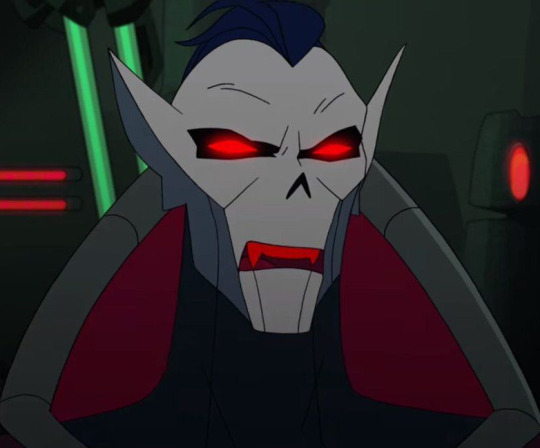
One of my favorite things about 2018 She-Ra is Hordak's story and development (and Entrapdak cough but that's not the point of this particular post), and the cleverest thing is that so much of it is actually being set up and told to us in seasons 1 and 2 before we even realize that that's what's happening.
When we first see Hordak in the show, he's giving "generic evil overlord" vibes. Garden-variety baddie. Maybe a little more reasonable than some and clearly capable of long-term thinking, but that just serves to make him intimidating. Everything about him--the way he runs his empire, his armor, his color scheme, his minion, his Villainous Eye Makeup(TM), even his name--are all projecting to the audience "yup, Acme Bad Guy here. Move right along."

But then, backstory. And everything snaps into focus. Not only is it one of the first big oh SHIT moments of the show, where we suddenly zoom out and realize that there is SO much more going on than we realized--it's also the start of the audience seeing Hordak as a character rather than an archetype. Suddenly we realize that he's not conquering Etheria because he wants power, or hates happiness and sparkles, or whatever--he's doing it out of a desperate attempt to prove his worth to his brother/creator/god. This moment where Hordak lets Entrapta in is also the moment the show lets us in on what makes our favorite spacebat tick.
On top of that, we've also seen him bonding with Entrapta and opening up to this person that he respects and trusts...probably the only person he's ever respected or trusted apart from Prime. And she's Etherian--someone of a lower species, someone he's supposed to subjugate, someone who he has been raised and trained and programmed and mind-controlled into believing is below him in every way.
But instead she's brilliant and creative and mesmerizing. She's not afraid of him, and she's fascinated with his work. For the first time since being abandoned by Prime, Hordak finally has someone that he can talk to, who is on his level and both understands and cares about the science! (because he is a giant nerd). She's kind to him, a mere defect. And it just sends his whole worldview into a spin, and that's all before--
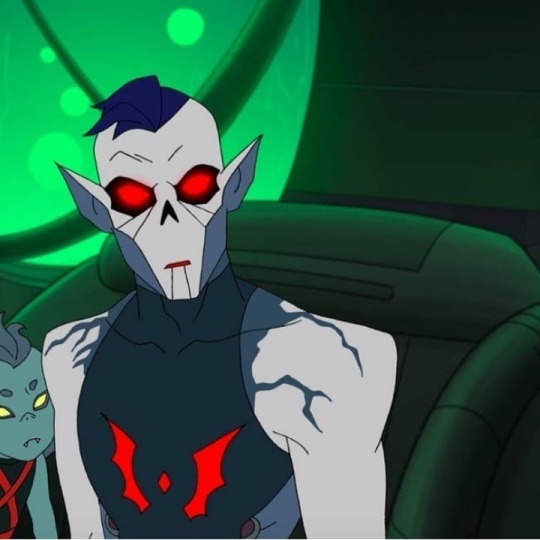
Bam, mans is a goner. Entrapta's "Imperfections are beautiful" comment punches right through all the toxic bs that Hordak has been steeped in his entire life. You can see on his face here--I think it's the moment Hordak fell in love with Entrapta, but this is also the face of a spacebat reevaluating his entire worldview. If Entrapta, who is amazing, believes something different from Prime...what does that mean? If Entrapta, who is brilliant, believes that he is worth something, and that she herself is a failure...
Well. We know what happens after that, and how Hordak begins to doubt, and eventually fights back against Prime (and remembers his love for Entrapta after TWO mind wipes help my heart ack). But we also get to see what life in the Galactic Horde looks like: the only life Hordak ever knew before coming to Etheria.

It's not nice.

It's really not nice.

Prime operates in a very specific way, and we learn a lot about it in season 5. Prime expects complete obedience, devotion and worship from his clones. He allows no individuality from his subjects, not even a name. Failure or deviations are punished, mind-wiped, or destroyed. We even learn from Wrong Hordak that facial expressions are considered a privilege reserved for Prime (apart from, presumably, expressions of rapture caused by being around Prime).
And once we learn all of this, suddenly thinking about season 1 Hordak becomes very interesting indeed. The time we spend with the Galactic Horde and Prime throws absolutely everything that we know about Hordak into a whole new context. Now all those traits that made him a generic villain are actually hugely effective characterization! And what that characterization is telling us is that Hordak had already moved much farther away from Prime than we (or, probably, he) had realized, even long before he met Entrapta.
Horde Prime does not allow his underlings to have names, personalities, or any differences of appearance. Not only does Hordak allow this among his own troops, he chose a name for himself as well! Season 5 tells us that his very name is an act of blasphemy against his god. And yet Hordak took one for himself, and that name is part of the core identity he is able to hold on to when rebelling against Prime.

Horde Prime cast Hordak out when he showed signs of physical imperfections. Hordak not only keeps Imp (who is by all appearances a failed clone or similar experiment) around, he treats Imp more gently than we see him treat anybody or anything before Entrapta. Imp is not simply "generic evil guy's minion," he is proof of Hordak's capacity for compassion, and evidence that Hordak cannot bring himself to cast aside "defects" as easily as Prime. Considering where Hordak came from, Imp's existence is a huge, flashing neon sign telling the audience this guy here is better than the hell that molded him, and we don't even realize it until 4 seasons after it's been shown to us!
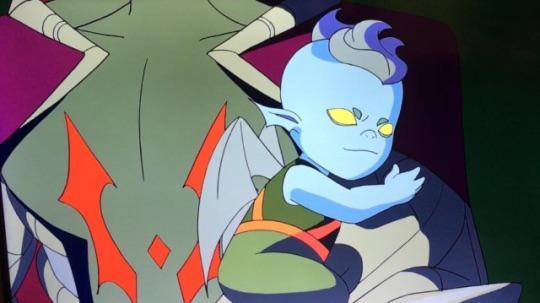
Very cool, ND.
There's more, though. Hordak's red and black color scheme? His dark eye makeup and lipstick? Very Evil Overlord chic. But nope! Actually these are actually expressions of individuality on a level that Hordak knows would be abhorrent to Prime!
Reading between the lines, I see this as Hordak desperately trying to reconcile two diametrically opposed beliefs in his head: (1) devotion to Prime, whose approval he desperately craves, and (2) maintaining some degree of unique personhood, of Hordak, from which to draw strength. Because a failed, defective clone cannot survive on a hostile world, cut off from the hivemind and from Prime's light. A failed clone cannot create an empire to offer Prime as tribute, nor build a spacetime portal from scraps and memory to call Prime back. A failed clone cannot create cybernetic armor to keep his hurting, weakened body alive; to force himself to keep going no matter what, to fight through the pain and the doubt by sheer force of will.
But maybe Hordak can.
And so there it is. Hordak had plenty of time to gain and explore his individuality while separated from Prime, but I think the reason he did it so effectively (while still deluding himself that Prime would forgive him for these little sins, if only Hordak could prove his value) is because he had to.
Wrong Hordak gained his individuality surrounded by kind, quirky people who took care of him; Hordak was ripped from the hivemind by Prime himself and had to fight for his survival against all odds. And that produced a dangerous and damaging foe for Etheria. But it also produced the one clone with the strength of will to defy Prime himself.

This is long and rambling, but ultimately my point is that 1) I love Hordak, and 2) I love love love love that the show was so clever about his characterization. We learn so much about him and how much progress he's already made in breaking from his psycho abusive cult upbringing, and we don't even recognize it until the show wants us to. Hordak had come so far, all on his own, before he met Entrapta. She just helped push him over the edge and finally realize (at least consciously) that Prime's worldview might not be the correct one.
Idk, I just don't know if I've ever seen all the trappings of Basic 80's Villain(TM) so successfully subverted, where looking back 4 seasons later is actually a smack in the face with the "effective character building" stick. Amazing.

#spop#she ra#she ra and the princesses of power#hordak#entrapdak#entrapta#horde prime#Spacebat#Deep character analysis#Gotta love clever writing#Seriously I could go on about this show for ages#I just love the characterization for everyone but especially Hordak#Best spacebat#I mean I love Wrong Hordak too but you know
1K notes
·
View notes
Text
I really love the 'queer utopia' part of the She-Ra world building.
It's not a utopia in the sense that there are no problems - structural or otherwise (as amply demonstrated by pretty much the entire show). But there is no queer discrimination. Catra and Adora are not kept apart by homophobia but by war and abusive assholes. Bow struggles to come out to his parents not about his sexuality or gender, but about his career choice and politics. Hordak has a thousand problems, but the gender-transgressing aspects of his fashion sense is not one of them. No one hesitates to give Kyle shit, but if anyone would try to taunt him for being into boys it would just come across as weird.
And I love how that's reflected in the greater fanon when it comes to the question of how people of the same gender get children in next gen fics, because the answer is: In whatever way we feel like exploring today.
Just on the top of my head I have seen Adoption (formalised or 'is no one going to raise this urchin? Fine, I'll do it myself), Trans parents, Sperm donors, Sperm donors that's part of the greater family unit, downright policules, Magic (as in miracle, casual Etherian healthcare or 'comes with a price'), Mpreg and Fempregnation (magical or otherwise), Cloning (and other variants of 'build them ourselves'), Egg laying or simply "arrangements were made". Sometimes the same story mixes several modes, and there is never a discussion that one way is better than the other.
Kids are kids, and regardless how they came to be they will get into adorable and/or angsty shenanigans just like the rest of them.
172 notes
·
View notes
Text
I think Entrapta works best as this weird mysterious cryptid like figure who raises more questions than answers yet is still an adorable science gremlin. why does her hair move? Idk. Why was she raised by robots? idk. Where'd she hire the kitchen staff? I don't know, maybe she kidnapped them, maybe she put an ad for them on Etherian Craigslist.
I don't mind giving lore to the other She-Ra characters like Mermista and Perfuma and Scorpia.... but Entrapta, I think it might be best to deliberately leave it vague because it's just waaaaay better that way.
313 notes
·
View notes
Text
The Aftermath
The Beacon is a very... disjointed episode. It has the unfortunate placement of between two episodes that are, in my opinion, the two best that the show has to offer, and it doesn't matter how good this episode is, it suffers in the contrast.
The Beacon is trying to set up The Promise and still recovering from No Princess Left Behind, which means that it struggles to tie both together without feeling like a ton of disconnected events.
So, for the sake of analysis, let's look at those events on their own, and see what they do for the story as a whole. Because some of them are really well written.
Let me explain.
SPOILERS AHEAD
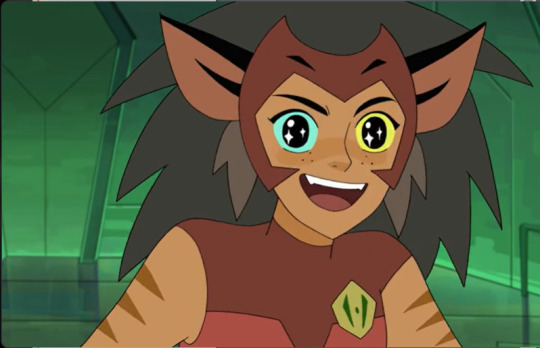
Catra's moments in this episode are genuinely some of the best little moments for her in the series. We see her kind nature start to show, ever so slightly. She is not kind, I want to stress this, a few actions do not make a redemption (yet), but we start to plant the seeds of that here.

In Entrapta's interrogation scene, we see Catra being manipulative, that much is obvious. But it's interesting how she does it. Catra doesn't belittle, or lie, or even seem disingenuous with her compliments, she is just aware that compliments lead to allegiances, and she is trying desperately to befriend the single smartest person on Etheria.
"You're not mad? People usually get mad."
"Are you kidding?"
There is an empathy here with Catra. I mentioned in the previous post that everyone's greatest strength is their greatest weakness. And the same is true for Catra. She is exceedingly emotionally attuned. She sees herself in Entrapta, as the person left behind. The side effect of this is that she falls on her sword a bit when Adora leaves, but also in a weird, other way.

"Don't worry about that thing with Hordack. I've got plenty of experience getting yelled at... you get used to it."
Catra is talking to Shadow Weaver here, of all people. Why? Because she sees a person feeling low, and offers some condolences. Without concern for who she is, or what she has done. Catra offers a hand of peace. I want to stress that empathy isn't a weakness, that's not how this works, but it makes her easy prey for Shadow Weaver, because Catra is a child, a teenager, who is naive, and Shadow Weaver is evil.
But how does Shadow Weaver return the openness that Catra has displayed?
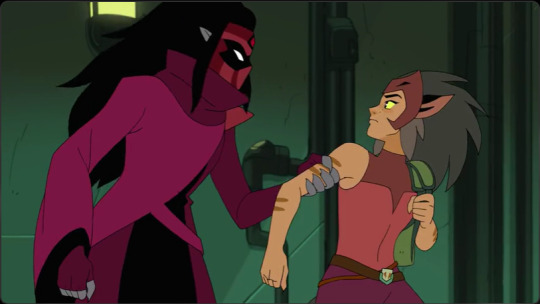
"I will not get used to mediocrity like you"
She returns kindness with an insult, and through her touch. Shadow Weaver desires power above all else, so when she is at her weakest, she tries to grab it from the one person she thinks she can mentally overpower.
This is why Catra is the way she is, any attempt at kindness is met with animosity for reasons she has no command in. But that little influence of Adora, and now Scorpia and even Entrapta, has kept the instinct alive. The empathy is there, just buried deep under the surface.

"I just wanted to prepare you for the world"
I love that Shadow Weaver has worked out her tactics are failing on Catra, so she tries giving the Adora treatment to her, and even that fails. I think that's rather satisfying. I pity her, but it is definitely gratifying to see her this low.
Shadow Weaver fits the same bill as everyone else in the series (strengths and weaknesses being the same), but she forms a weird parallel with Bow of all people. Shadow Weaver thinks big picture, she is the strategist, and she gets undermined time and again by the tiny things, such as personal determination, and unconditional love. This parallel isn't dwelled upon, but it's a neat thing to point out that Shadow Weaver's opposite isn't Catra or Adora, but Bow.

Speaking of Bow. The man is supportive of everyone, similarly to Sea Hawk. Bow still thinks big picture, but the difference between him and Shadow Weaver is that when Bow meets a wall, instead of thinking of a way to break it down, he finds another route. Bow is a strategist of the heart, making sure everyone is at their best and ready to step in to keep people's moral up, should they need it.
I also really like Glimmer's line:
"Your sorry is wrong and mine is right."
I think this is extremely revelatory about Glimmer, but that won't come up for a while.

Finally, there is Adora.
Under stress, she reverts. This is what Shadow Weaver did to her, she gave her a few set behaviours in response to certain stimuli. Notably, when scared, punch what I tell you. Shadow Weaver isn't here to give a target, so Adora decks the first thing she can get her hands on. Namely, this light.
There are other sections in the episode when she is in the background of other shots. And instead of just standing there, and looking apathetic, she shadow boxes. Adora cannot focus when she's directionless.
So naturally, she jumps at the opportunity to heal Glimmer, including possibly stabbing her, just to feel useful. Again, preprogrammed responses. She needs to feel useful, so she will run towards whomever is offering her that purpose.

"You want me to be weak? Well (Throws Sword), I am"
This leads into the above line. Adora believes she needs to be weak, and the first thing she does to achieve that is return to her original form and throw away her sword. Adora has associated strength with ability to achieve a given task. In this case, heal.
But the fascinating thing is how she goes about the accountability of failing. She has a weird internalisation of good things being She-Ra's fault, and bad things being Adora's fault. It's awful.

I'm going to finish this on a mildly happy note, because Glimmer and Angella have a really sweet interaction in this episode. Its the reassurance that a parent figure can offer. She offers support, and affirmation that this may not have worked, but it wasn't because of Glimmer's ideals, but her methods, which can be worked on.
Compare the following two lines.
"I will not get used to mediocrity like you"
"We'll figure it out, together."
I have boldened a few words, because they reveal character quite nicely. One tries to separate the speaker from its subject, complete with an insult and a comparison, the other is supportive and constructive, and strives to make the listener understand this fact. Angella is a great mum.

Final Thoughts
This episode isn't particularly memorable. Which isn't its own fault. It is sandwiched by The Promise and No Princess Left Behind, which both render it rather uninspiring.
But this episode is actually quite decent. Its moments string together cohesively enough, and Marcus Scribner (Bow's Voice Actor) kills every line.
However, that opening sequence steals the show for me, as everyone leaves on their own way. That was why Entrapta's fake out death doesn't feel cheap. It actually hurts these people, and they don't get over it. This is a death that has its cake and eats it too, and that's a difficult thing to pull off. I think the thing that sells it is this is the only scene so far in the show (I think) in which Sea Hawk stays quiet, the events of the previous episode have managed to make the bard stop singing.
Previous - Next
#rants#literary analysis#literature analysis#what's so special about...?#character analysis#she ra and the princesses of power#she ra catra#she ra adora#she ra spop#adora#catra#spop#shadow weaver#she ra#she ra princess of power#she ra bow
82 notes
·
View notes
Text
ok people here's my essay. (also note that this was for my english class so it is written in a different style than i usually would. it had to be all formal and grammatically correct and such)
2212 words, analytical essay
She-Ra and the Princesses of Power: A Queer Allegory for Religious Trauma
ND Stevenson’s She-Ra and The Princesses of Power is an animated Netflix original series rebooting the classic 80s show Shera: Princess of Power. This time, however, the show is chalk-full of diversity, varied body types, queer representation, pleasing colour palettes, and a friends-to-enemies-to-lovers lesbian romance. The first four seasons follow Adora (aka She-Ra) and the princesses of Etheria’s fight against the Evil Horde, using their magic to try bringing peace and justice to the planet. A portal is opened at the end of the fourth season, however, bringing the planet of Etheria out of the isolated dimension of Despondos. No longer separated from the rest of the universe, Horde Prime arrives at Etheria- not only bringing higher stakes than any season preceding it, but an entirely new layer of symbolism to the series. The final season was a clear allegory for religious trauma, an especially relevant topic for the show’s majorly queer audience.
When his armada arrives at Etheria, Horde Prime sends his army of clones and robots down to take the planet by force. Unlike the Evil Horde that had been trying to take the planet before Prime’s arrival, who were disorganized, messy, and industrial, everything under Prime is sleek, elegant, efficient, and most importantly: white. Horde Prime’s ships are white, Horde Prime’s robots are white. Horde Prime’s skin is white, his hair is white, his clothes are white, as are all his clones. Pure, unblemished white, with only sparing accents of grey or green.
In colour theory, white has a few meanings. The colour can represent purity, cleanliness, innocence, and even righteousness. This colour theory is heavily incorporated into biblical verses, metaphors, and artwork (and some might even argue that our modern idea of white comes from the Bible). In art, God and angels are almost always depicted wearing white, as is Jesus in his resurrection. Halos of white or light yellow are shown adorning holy figures' heads. Several bible verses use white robes or other white objects as a metaphor of the wearer’s purity. White is still used in several Christian rituals/customs today, such as weddings, baptisms, and more. White is one of (if not the) most important colour in Christian lore. Even in instances where pure white isn’t used, there is a clear correlation between light versus dark and good versus evil.
White has more than one meaning, however- on the opposite side of the coin, white can also represent coldness, blankness, emptiness, and loneliness. The most interesting thing about the show’s use of white is that it encapsulates both facets of its representation. Horde Prime uses white to represent his purity and perfection, but to the people of the colourful, messy world Etheria, this is a cold, eerie colour. As are Horde Prime’s ideals. His perfection and purity is synonymous to coldness. The white represents both- not only simultaneously, but as the same thing.
Horde Prime’s empire being entirely white is no coincidence- neither in-story by Prime, nor in real life by the writers. Horde prime uses white to represent everything he stands for, and the writers use white to represent everything Christianity stands for.
Horde Prime is a being that has lived an amount of lifetimes beyond comprehension- every time his body starts to grow old and fail, he selects a new clone of his to insert his memory and very essence into. So even though he has a new body, he is still him. And the reason for this? To fulfill his self imposed purpose of bringing peace and perfection to the universe. To thousands of planets he has been, one at a time, to reach this. Horde Prime believes there is only one right way to do things, and that humanity cannot be trusted to govern themselves.
Every planet he takes goes the same: he arrives with his ships, and slowly implants chips into the neck of each and every being on a planet. These chips take away the autonomy of the host, and they are left blank. No personality, no choices, no person. All their actions are perfectly automated and controlled by a hive mind, and Horde Prime can take specific control of and see through the eyes of any individual at any given time. With Horde Prime in control, there is no war, no famine, no pain. There is only peace, perfection, and purity. And anyone who does not conform, does not accept his gracious rule, are dealt with accordingly. Entire planets have been left desolate and barren, entire peoples subjected to genocide for not accepting Horde Prime. All dead in the name of peace.
These ideals upheld by Horde Prime are strikingly similar to Christianity. Perfection and purity are two of the main ideals of Christianity, in hand with righteousness. Christians strive to “be like Jesus,” to be their idea of a good person, to be loyal to their religion, and to make it into Heaven. Several rituals to “repent” exist when they feel they have not upheld these standards correctly- including prayer, confessionals, sacrament, and baptism. Even though true perfection, purity, and righteousness are typically seen as unattainable to everyone but the Godhead, it is common belief that constant trying will at least get you as close to it as possible. Conformity is another key aspect of Christianity, though it is not advertised, and to the exact extent it is upheld depends on the sect. In general, though, Christianity pressures every one of its followers (and even those who aren’t) to behave a certain way, to think a certain way, and to only associate with others among themselves.
Horde Prime’s way of upholding these ideals isn’t dissimilar to Christianity’s either. Much like Horde Prime’s Galactic Empire, Christianity has had a long history of forced assimilation. From the Spanish conquistadors to the pilgrims and other colonial settlers of North America, death and pain has come in the wake of the spread of Christianity for hundreds of years, amongst various sects of the religion. Native peoples have been murdered for their loyalty to their “savage” non-Christian ways, land has been stolen, and indigenous religions and other important cultural traditions have been changed past recognition or completely erased, all in the name of “saving,” all in the name of “love,” all in the name of “what’s right,” all in the name of God. Christianity is the only right way, Horde Prime is the only right way.
Its likeness to Christianization isn’t the only resemblance Horde Prime’s ways share with Christianity, however. When Horde Prime arrives at Etheria, three people are brought aboard his ship- Queen Glimmer, one of the Etherian rebels that had been fighting against the Evil Horde (and now the Galactic Empire), Catra, a high-ranking member of the Evil Horde that had been taking over Etheria before the Galactic Empire arrived (but is in love with Adora, who is one of the rebels), and Hordak, the leader of the Evil Horde. Hordak was a clone of Horde Prime’s that had been stranded on Etheria, which was in an isolated dimension. He spent his time in isolation trying to take the planet so that if he was ever reunited with Horde Prime, he would be seen as “worthy”. Horde Prime, however, is displeased by Hordak’s actions- claiming that Hordak was trying to take the planet for selfish reasons rather than for Horde Prime, and for giving himself a name. As such, Hordak must be “purified.”
In this purification process, Hordak’s mind is wiped, and he begs for forgiveness and to complete the process. He is then dressed in white and walks into a circular pool with liquid that reaches his waist. The liquid is electrified for several moments, and his screams can be heard, and then it stops. He is left blank, and Horde Prime and the other clones watching praise him for being the purest among them. Later, Catra is subjected to the same process against her will, and is now a mindless servant of Horde Prime as well. This process is almost identical to the Christian concept of Baptism. While exactly how baptism is carried out varies between sects (full submersion under water versus just a sprinkling, infant versus child, etc), the purpose remains the same- to purify past sins.
A more abstract similarity between Horde Prime’s empire and Christianity is the use of titles. Prime’s clones refer to each other as “brother” (and to Catra as “sister,” once she has been “purified”), and Horde Prime as “big brother.” Not all sects of Christianity use such titles to refer to each other, but some do; notably Catholic nuns or members of the Church of Jesus Christ of Latter-Day Saints (Mormons). But even those sects who do not refer to each other as brother and sister often view Jesus as their “older brother” and God as their “heavenly father.”
Horde Prime himself has many more titles than simply “brother” or Emperor of the Galactic Horde, however. Other titles given to him include Ruler of the Known Universe, Regent of the Seven Skies, He Who Brings the Day and the Night, Revered one of the Shining galaxies, and Promised one of a Thousand Suns. In Christianity, Jesus also is referred to by many names. The Saviour, the Redeemer, the Son of God, the Son of Man, King of Kings, Lord of Lords, the Prince of Peace, the Lamb of God, and several more. In addition to titles, some of the phrases in general used by Christians and the Galactic Empire are common. Both use the word “rejoice” when telling of their faith. Amongst Christians, “glory to God in the highest” and “[God] is the same yesterday, today, and forever” are not uncommon phrases. “Glory be to Horde Prime” is a common phrase expressed by the clones, and even more so, the infamous mantra “Horde Prime sees all, Horde Prime knows all” repeated so many times throughout the season.
The titles used for each other perpetuate a feeling of conformity and a feeling of “otherness” concerning those who do not conform. The titles used for their leaders perpetuate subservience, power imbalances, respect, and devotion. The phrases used in relation to their leaders perpetuate devotion and omnipotence. These are true of both Horde Prime’s Galactic Empire and Christianity.
Horde Prime was a genuinely disturbing villain who represented every painful thing Christianity is made of- toxic perfectionism and purity, conformity, obedience, control, and omnipotence. Loss of expression and individuality. The fear of being constantly watched. These are things that anyone with religious trauma may deal with, but it’s especially true of queer people. Queer people have had a long history of oppression at the hand of Christianity (and colonialism in general). From outright murder to conversion therapy and other abuses, from abandonment to dismissal, Christianity has perpetuated all of it for centuries. And it’s still something that happens today.
She-Ra and the Princesses of Power has a majorly queer audience, due to both the creative process of the show and the representation within the series itself. Not only is the creator of the series (ND Stevenson) queer, but so was practically every character- whether they were a main character, side character, or background character with only a few seconds of screen time. One of the main plots of the show is the complicated lesbian romance between Adora and Catra. As such, the series attracted a good number of queer fans, and religious trauma (or at the very least, religious fear) is a topic that hits uncomfortably close for many.
Other pieces of media that incorporate religious imagery have a tendency to be unclear about how it is framed. Is the imagery shown to be wrong and the victim is right and prevails? Is the imagery shown to be right, and the pained victim in terrified denial? Is the imagery shown to be truly wrong but inevitably triumphant anyways, no matter what the victim tries? It is so muddy in so many pieces of media. The important thing about the fifth season of She-Ra and the Princesses of Power was how it was framed. Perhaps it was because it was a kids show, or perhaps it was the queer creators’ spirit and defiance, but the series was clear in their framing of Horde Prime. The perfect white make the audience uneasy. Horde Prime’s retelling of his victories fill the audience with dread and then hollowness. The “baptisms” of Hordak and Catra are disturbing. Every aspect of Horde Prime and everything he stood for was presented as wrong. Without any doubt.
And even more importantly, the people of Etheria were able to prevail. She-Ra and the other princesses were able to defeat Horde Prime and his empire, and free those forced into subservience by his chips. Catra (and Hordak) were saved. The ships were destroyed. The people of Etheria were allowed to be free and express themselves and be people. This message was something very important to the queer audience. Not only was the fifth season an expression of queer pain, but an expression of queer hope. Neither thing should be ignored. Pain is valid. Hope is needed. To be healthy, both need to be recognized. To have a series that expressed both, and in such a queer way, was extremely important to so many people.
#long post#unityrain.txt#tw christianity#religious trauma#christian religious trauma#ex mormon#shera#she-ra#she ra#spop#shera spop#she ra spop#she ra and the princesses of power#she-ra and the princesses of power#shera and the princesses of power#meta#analysis#analytical essay#horde prime#the galactic empire#hordak#spop meta
97 notes
·
View notes
Text
King from Toh : I am not adorable
Catra from spop : I am not cute
#shera#catra shera#shera catra#she ra catra#catra#spop catra#she ra princess of power#spop analysis#spop fandom#catra spop#toh king#the owl house#toh#the owl post#the owl house king#toh fandom
51 notes
·
View notes
Text
im rewatching she-ra and naturally im gonna want to write about it a lot. starting by breaking down the catradora conflict origin story scene from s01e02 the sword part 2
people have said this before but the most important thing to keep in mind here is how different their understanding of whats going on is. theyre both approaching this with completely different views and so they misunderstand what the other means.
Adora: There's no time. We have to put a stop this.
Catra: What? Why?
Adora: Because this is a civilian town. Look around! These aren't insurgents. They're innocent people.
Catra: Yeah, sure. Innocent people who kidnapped a Horde officer. Now come on, let's get you back to the Fright Zone. Shadow Weaver is freaking out. [laughing] It'd be funny if she weren't such a terrible person.

so immediately theres two things i wanna say about this part, about how catra reacts to stuff. first off, something we learn about catra throughout the whole show and especially in the portal-alternative-reality, is that shes big on Pretending Nothing Is Wrong. whenever shes feeling upset or angry about something, she will start joking around and acting like shes just totally super chill guys, dw ("Ugh, whatever. It's not like I even care. I just wanna get out of this dump at some point before I dieee of boredom). Shes acting like that in this scene. Adora was missing for hours, shadow weaver was breathing down her neck and threatening her, she was already worried adora might have left at this point. she cant let adora know how worried she was tho, so shes all jokes and fast paced conversation. To Adora, tho, it just looks like catra doesnt care, like she doesnt understand the gravity of the situation.
and the other thing is that honestly? I dont think catra does care. about the town, i mean. i think catra was ready for war in a way adora never was. theyre both seeing combat for the first time here, and adora hates it. training for war is completely different than being in the battlefield, and adora couldnt handle it. face to face with it she couldnt tolerate seeing people suffering and dying, houses being burned down, a whole village destroyed. when the horde brainwashed adora into thinking they were only doing the necessary to save etheria, she completely and fully believed it, and when faced with the reality of the horde she immediately realized how wrong that was. Catra, tho, could not care less. she never believed in what the horde said, she knew full well what the horde did, so this isnt a surprise for her. and i do think shes naturally a bit sadistic, or at least growing up among the violence of the horde made her so. either way, shes seeing battle here for the first time and shes completely fine with it. doesnt even spare it all a second glance. why would she care about these people she never met if the most important thing in the world is right here in front of her? (i think even if adora hadnt left that night and went into the battlefield as a force captain, she wouldve ended up deserting. she cant stand seeing people suffer and she cant stand not saving them. shes too good, too selfless for that. catra isnt.) (also she is so ready to kill at all times. she loves violence. i once saw someone say how shadow weaver thought adora was the "cutthroat, ruthless warrior" when that was actually catra and they were totally right)
adora is also trying something futile here, she doesnt need to explain to catra that the horde is bad and hurts innocent ppl because catra has known that all her life





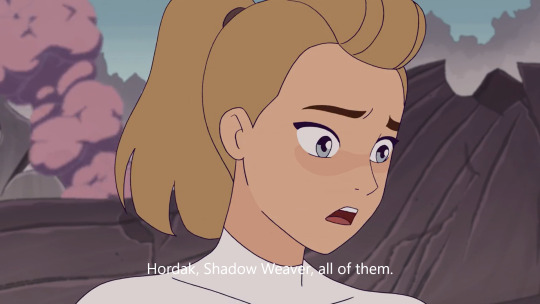



Adora: Catra, no. I can't go back. Not until the Horde leaves this town alone. You have to help me.
Catra: What are you saying?
Adora: I’m saying, this is wrong. They've been lying to us, manipulating us. Hordak, Shadow Weaver, all of them.
Catra: Duh! Did ya just figure that out? Manipulation is Shadow Weaver's whole thing. She's been messing with our heads since we were kids.
(the captions in the pics are slightly wrong, nvm that.) everything i said before. adora just realized all of this, while catra has always known, probably because the abuse adora suffered was more manipulation-and-brainwashing, while shadow weaver always made clear to catra that she didnt give a shit about her, so she suffered physical abuse with little attempt to convince her this was fine.
the "what are you saying?" is one of the things that show how different their perspective is. adora is talking about going against the horde and helping the town, while catra immediately gets more personal. what do you mean? are you saying that you might leave the horde? leave me?

Adora: How could you possibly be okay with that?
adora means, how could you be ok with the horde lying about its actions, and killing innocent people? how could you be ok with the horde raising us to do the same? and catra hears, how could you be ok with shadow weaver and hordak abusing us?


Catra: Because, it doesn't matter what they do. The two of us look out for each other. And soon we'll be calling the shots. Now come on, can we go home already?
catra replies: because, i love you. because you have my back and i have yours. because nothing really bad can happen as long as we have each other, remember? and soon enough, we'll be powerful enough that they cant hurt us anymore. Adora hears, because i dont care about these people dying, the only thing thats important is you and i. and anyways, soon its gonna be Us killing them, isnt that good? lets go back home to the evil murder place.

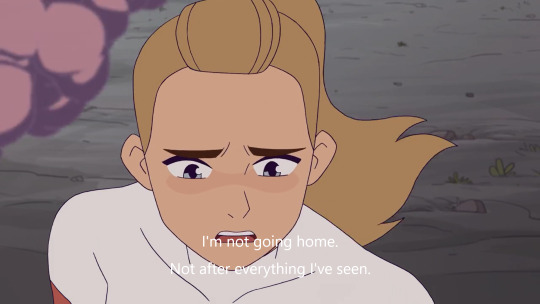
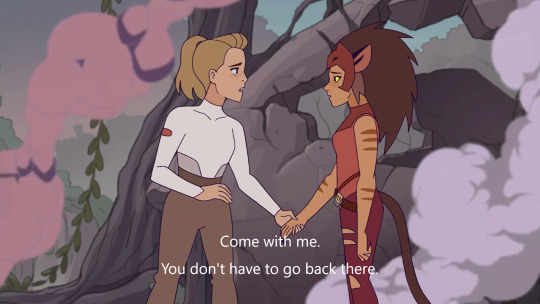
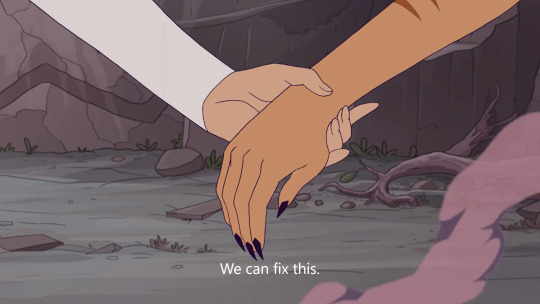
Adora: I'm not going home, Catra. I can't. Not after everything I've seen. Come with me. You don't have to go back there. We can fix this.
adora says: im starting to realize now how wrong i was about everything. we're not the good guys, and i cant stand for that. i cant stand around and watch people get hurt. i cant stand around and watch you get hurt. lets leave, together, and have a better life, please. lets do the right thing.

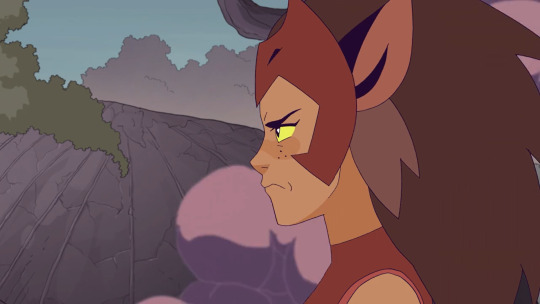
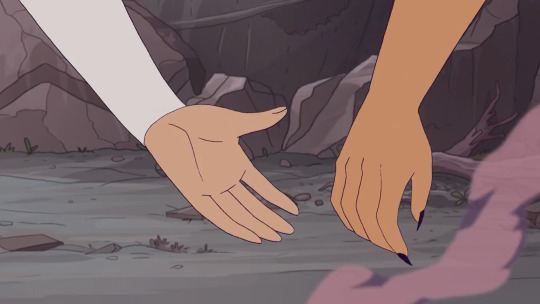
Catra: Are you kidding? You've known these people for, what, a couple of hours? And now you're just gonna throw everything away for them?
catra hears, shes willing to leave me. after everything i did for her, all that i took, all of these years of us being together, she would still leave me. she would break our promise. she would leave me behind.
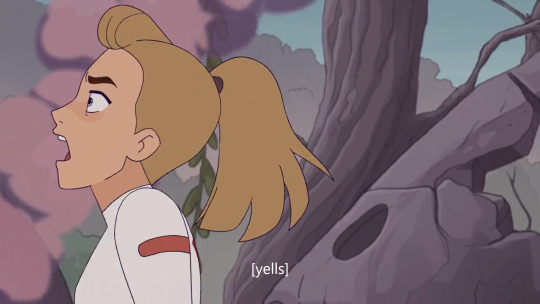
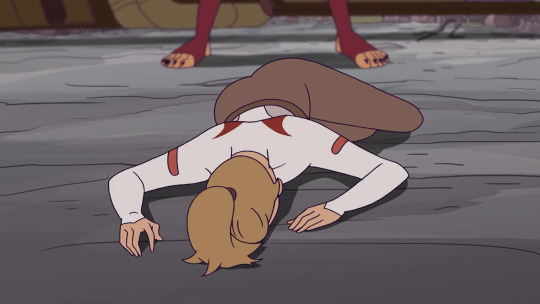

and then she straight up electrocutes adora. ok
she says it was a reflex, but i dont know if i believe her. i dont think she likes hurting adora (not physically. not by this point, anyways), but i do think that shes the type to lash out when upset and immediately regret it, then feel guily about it. which just makes her more upset. :(
Catra: Oh, man. That was a lot stronger than I thought. Are you okay?

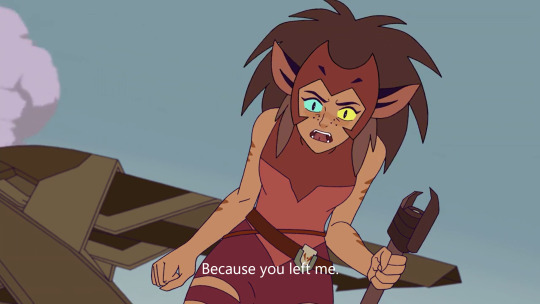
Adora: Why are you doing this?
Catra: Because you left me! And if I don't bring you back, Shadow Weaver’s gonna have my head. So, enough with your weird little identity crisis and let's go home already. Or do I need to zap you again?
thats the last time they talk. adora gets teleported away by glimmer, and when they see each other again, its clear that they both made their choice.
the moment adora showed catra she was willing to leave her, there was no coming back for them. because catra would never get over that. she'd spend all her life in that hellscape, putting up with abuse and bullying and probably so much more we dont get to see, because of the promise adora made her. and, in her eyes, adora was ready to leave her on the first opportunity that came up. that hurt. that broke her. and that released something really ugly inside of her.
cue in 2,5 years of homoerotic rivalry and trauma. ok post over if you read this i hope you liked it <3 bye
#autism won today this took me 1 hour to write#she ra#catra#character analysis#ig??#edit while reading old spop posts by other ppl i realized my mind might have plagiarized this from a post i read several years ago. my bad#it wasnt a conscious decision
135 notes
·
View notes